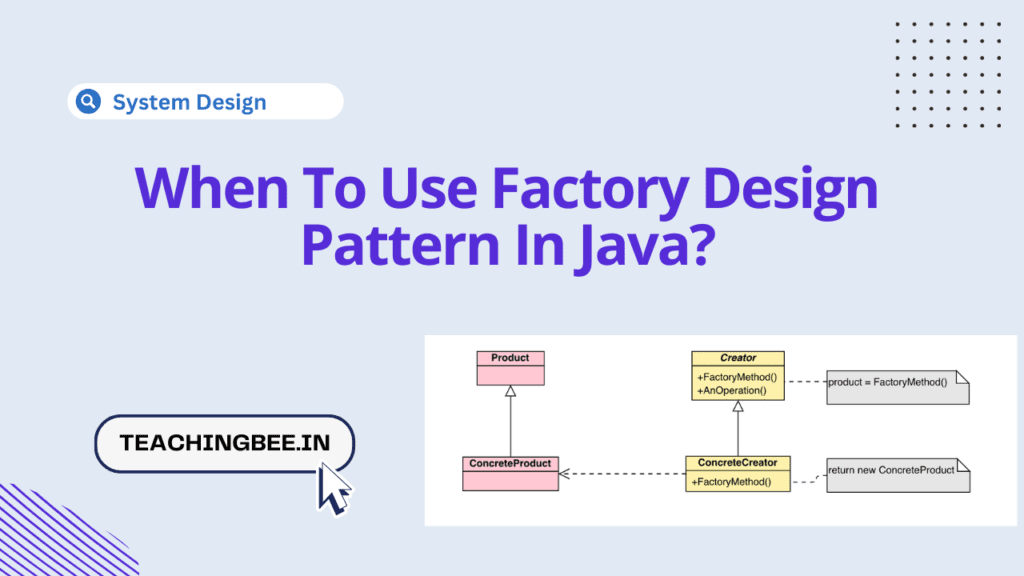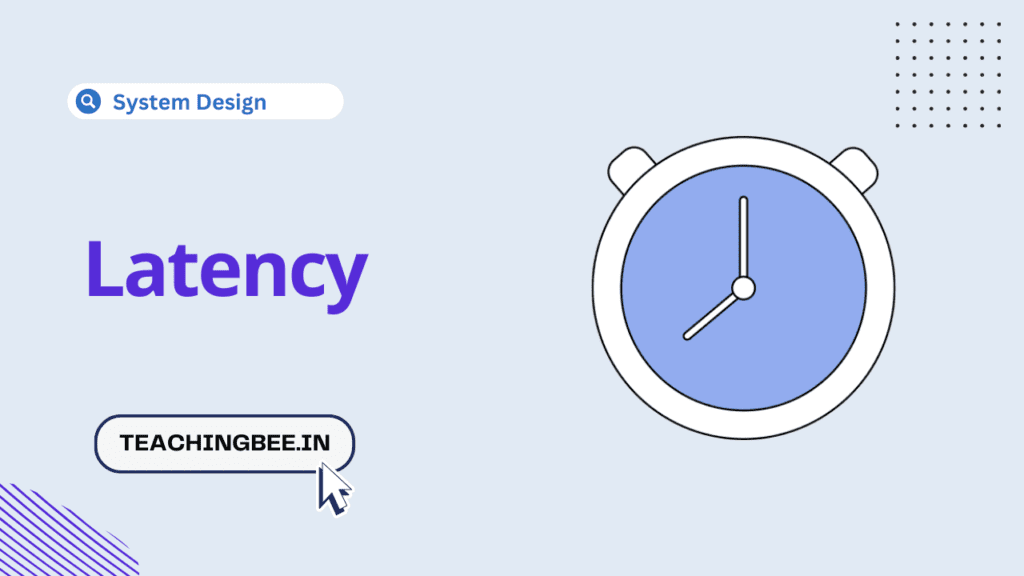Table of Contents
ToggleThe Factory Design Pattern is a creational pattern in Java that provides an interface for creating objects in a superclass, but allows subclasses to alter the type of objects that will be created. It encapsulates object creation logic to make code more modular, flexible, and easier to maintain. Understanding when to employ this pattern is crucial for crafting robust and scalable Java applications.
Let’s see where applying Factory Design Pattern proves to be advantageous:
When To Use Factory Design Pattern In Java?
Let’s see scenarios for when To Use Factory Design Pattern In Java:
Dynamic Object Creation Requirement
When the type of objects to be created is determined at runtime based on conditions, parameters, or configuration.
If your application requires the flexibility to create different types of objects based on dynamic factors, such as user input, system settings, or external data, the Factory Design Pattern can provide a structured approach to handle such scenarios.
For Example
Imagine a document generation system where users can choose the type of document (e.g., PDF, HTML, or XML) based on their preferences or system settings.
By implementing a DocumentFactory with methods like createDocument(), the application can abstract the creation logic. Depending on runtime conditions (e.g., user input or configuration settings), the factory method can instantiate the appropriate document object (e.g., PdfDocument, HtmlDocument, XmlDocument) without exposing the intricate creation details to the client code.
public class DocumentFactory {
public Document createDocument(String type) {
if (type.equalsIgnoreCase("PDF")) {
return new PdfDocument();
} else if (type.equalsIgnoreCase("HTML")) {
return new HtmlDocument();
} else if (type.equalsIgnoreCase("XML")) {
return new XmlDocument();
} else {
throw new IllegalArgumentException("Invalid document type: " + type);
}
}
}Hiding Complex Object Creation Logic
When object creation involves complex initialization logic, including setting specific parameters, resolving dependencies, or handling exceptions.
If creating an object involves intricate steps that may vary based on the context or require dealing with multiple dependencies, using a factory method can encapsulate this complexity and promote code clarity and maintainability. For Example
Consider a game development scenario where different types of characters (e.g., warriors, mages, or archers) need to be instantiated with varying attributes and equipment.
By utilizing a CharacterFactory, the game engine can hide the complex logic involved in character creation. The factory method can handle tasks like attribute initialization, equipment allocation, and error handling, shielding the client code from unnecessary intricacies and promoting maintainability.
Family of Related Classes
When multiple classes share a common interface or superclass, but the specific implementation needs to be determined dynamically.
If your application deals with a family of related classes that exhibit polymorphic behavior, the Factory Design Pattern can centralize the creation of these objects, enabling consistent instantiation and facilitating adherence to design principles such as the Open/Closed Principle (OCP).
For Example
In a banking application, various types of accounts (e.g., SavingsAccount, CheckingAccount, or LoanAccount) share a common Account interface but differ in their implementation details.
By employing an AccountFactory, the application can dynamically create account objects based on user requests or system requirements. The factory method can return instances of specific account types while adhering to the common interface, allowing the client code to interact with accounts polymorphically without being concerned with the underlying implementation.
Dependency Injection and Testability
When practicing dependency injection (DI) and aiming to enhance testability by decoupling object instantiation from client code.
By injecting factory instances into classes instead of directly instantiating objects, you can improve testability by easily substituting dependencies with mock objects during unit testing. This promotes the principles of Inversion of Control (IoC) and facilitates the application of test-driven development (TDD) practices.
For Example
Suppose a messaging application relies on different messaging services (e.g., EmailService, SMSService, or PushNotificationService) for communication.
By injecting a MessagingServiceFactory into the client classes, the application can decouple object creation from usage. During testing, mock implementations of messaging services can be provided via the factory, allowing for isolated unit tests without relying on external dependencies. This approach facilitates easier testing and promotes code maintainability.
Dynamic Class Loading
When dealing with scenarios requiring dynamic loading of classes at runtime, such as in plugin systems or modular architectures.
The Factory Design Pattern facilitates the dynamic creation of objects from classes loaded at runtime. By employing factories, you can maintain a structured approach to manage object instantiation, enabling greater flexibility in extending and customizing the application without modifying existing code.
For Example
In a content management system, users can extend functionality by installing plugins that provide additional features (e.g., image galleries, contact forms, or social media integrations).
Utilizing a PluginFactory, the CMS can dynamically load and instantiate plugin objects based on configuration files or user preferences. By abstracting the creation process, the CMS remains agnostic to the specific plugins being used, promoting modularity, and enabling seamless extensibility without requiring modifications to the core system code.
// Plugin interface representing the functionality provided by plugins
interface Plugin {
void execute();
}
// Concrete implementation of a plugin for image gallery feature
class ImageGalleryPlugin implements Plugin {
@Override
public void execute() {
System.out.println("Image gallery plugin activated.");
// Additional logic for image gallery functionality
}
}
// Concrete implementation of a plugin for contact form feature
class ContactFormPlugin implements Plugin {
@Override
public void execute() {
System.out.println("Contact form plugin activated.");
// Additional logic for contact form functionality
}
}
// Concrete implementation of a plugin for social media integration feature
class SocialMediaIntegrationPlugin implements Plugin {
@Override
public void execute() {
System.out.println("Social media integration plugin activated.");
// Additional logic for social media integration functionality
}
}
// Factory class responsible for creating plugin instances
class PluginFactory {
// Method to create plugin instances based on plugin name
public Plugin createPlugin(String pluginName) {
switch (pluginName) {
case "ImageGallery":
return new ImageGalleryPlugin();
case "ContactForm":
return new ContactFormPlugin();
case "SocialMediaIntegration":
return new SocialMediaIntegrationPlugin();
default:
throw new IllegalArgumentException("Invalid plugin name: " + pluginName);
}
}
}
// Client code demonstrating the usage of the PluginFactory
public class Main {
public static void main(String[] args) {
// Suppose pluginName is obtained from configuration files or user preferences
String pluginName = "ImageGallery";
// Create PluginFactory instance
PluginFactory factory = new PluginFactory();
// Create plugin instance using the factory
Plugin plugin = factory.createPlugin(pluginName);
// Execute plugin functionality
plugin.execute();
}
}
Conclusion
In summary, the Factory Design Pattern proves beneficial in various scenarios where dynamic object creation, complex initialization logic, polymorphic behavior, dependency injection, and dynamic class loading are involved. By adhering to the general rules and recognizing specific use cases, developers can effectively leverage the Factory Pattern to enhance code maintainability, flexibility, and testability in Java applications.
Similar Posts
How Factory Design Pattern Is Used in Spring Boot?
How to Apply Factory Design Pattern for Payment System
Can We Use Factory Design Pattern in Dependency Injection?
What Is the Difference Between Factory and Abstract Factory Design Patterns?
FAQ
What is the main goal of the factory design pattern?
The main goal of the factory design pattern is to provide an interface for creating objects in a superclass, but allow subclasses to alter the type of objects that will be created. It promotes loose coupling by abstracting the object creation process from the client code.
What is factory design pattern with real time example?
A real-time example of the factory design pattern could be a software application that produces different types of documents, such as reports, spreadsheets, and presentations. Instead of having the client code directly instantiate each type of document (e.g., Report, Spreadsheet, Presentation), a DocumentFactory can be used. The DocumentFactory provides methods for creating different types of documents based on user input or other factors. This way, the client code only interacts with the factory to obtain instances of documents, without being concerned about their specific implementation details.
What are the types of factory pattern?
There are several variations of the factory pattern, including:
- Simple Factory: This is the most basic form of factory pattern where a factory class has methods for creating objects without exposing the instantiation logic to the client.
- Factory Method: In this pattern, a superclass provides an interface for creating objects, but allows subclasses to override the instantiation process to provide different implementations of the created objects.
- Abstract Factory: This pattern provides an interface for creating families of related or dependent objects without specifying their concrete classes. It defines a set of methods, each of which returns a different abstract product.
What is the benefit of factory pattern?
The benefits of using the factory pattern include:
- Encapsulation: It encapsulates the object creation process, hiding the implementation details of object creation from the client code.
- Flexibility: It allows for easy extension and modification of the object creation process, enabling the addition of new types of objects without modifying existing client code.
- Promotes Loose Coupling: It promotes loose coupling between the client code and the created objects, as the client code only interacts with the factory interface, not with the concrete classes directly.
- Centralized Control: It provides a centralized place (the factory) to manage the creation of objects, making it easier to maintain and refactor the code.




